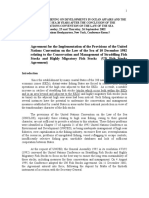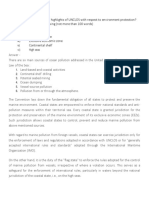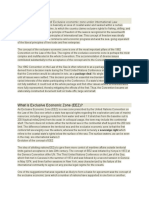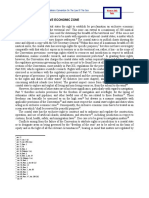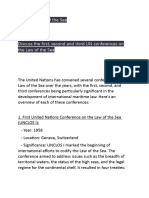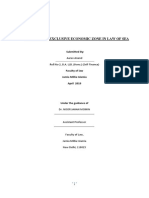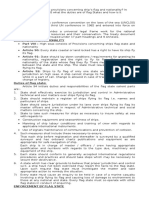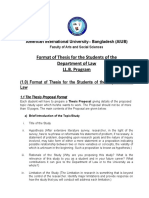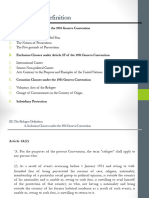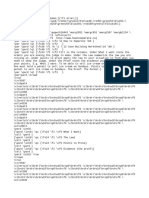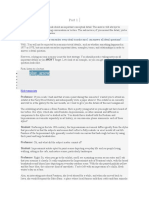Rights and Obligations of Coastal States in the Exclusive Economic
Zone (EEZ): Conservation of Living Resources and Protection of the
Marine Environment
Introduction
The United Nations Convention on the Law of the Sea (UNCLOS), 1982, often referred to as the
'Constitution of the Oceans,' represents the most comprehensive codification of international
maritime law. One of its most innovative contributions is the creation of the Exclusive Economic
Zone (EEZ) regime under Part V. The EEZ, extending up to 200 nautical miles from the baseline,
fundamentally transformed ocean governance by striking a balance between coastal state
sovereign rights and the interests of the international community.
Coastal states were granted extensive rights to explore and exploit resources in the EEZ, but these
rights were paired with obligations concerning the conservation of living resources and the
protection of the marine environment. This dual approach ensures that marine resources are not
exploited recklessly and that environmental sustainability is preserved.
I. Rights of Coastal States in the EEZ
Under Article 56(1)(a) UNCLOS, the coastal state enjoys sovereign rights in the EEZ for
exploring, exploiting, conserving, and managing natural resources. These rights extend to both
living resources (fish stocks and marine life) and non-living resources (oil, gas, minerals).
However, unlike the territorial sea, sovereignty in the EEZ is functional and limited to specific
purposes rather than absolute.
In addition to resource rights, Article 56(1)(b) UNCLOS provides coastal states with jurisdiction
over artificial islands and installations, marine scientific research (MSR), and the protection and
preservation of the marine environment.
UNCLOS balances coastal state rights with the freedoms of other states. Article 58 UNCLOS
affirms that all states enjoy the freedom of navigation, overflight, and laying submarine cables
and pipelines in the EEZ, provided they comply with coastal state laws consistent with UNCLOS.
�II. Conservation of Living Resources in the EEZ
Article 61 UNCLOS requires coastal states to determine the allowable catch of living resources in
their EEZ, based on the best scientific evidence available. They must ensure that species are
maintained at levels that produce maximum sustainable yield (MSY), considering ecological and
socio-economic factors.
While coastal states enjoy the primary right to exploit resources, Article 62 UNCLOS obliges
them to promote optimum utilisation. If they lack the capacity to harvest the entire allowable
catch, they must give other states access to the surplus.
Articles 63–68 address shared and migratory stocks. Coastal states must cooperate in managing
fish stocks across EEZs and on the high seas, while special provisions exist for highly migratory
species, marine mammals, anadromous and catadromous species, and sedentary species
associated with the seabed.
III. Protection of the Marine Environment in the EEZ
Part XII of UNCLOS (Articles 192–237) establishes a comprehensive framework for
environmental protection. Article 192 sets out the general duty to protect and preserve the marine
environment, while Article 193 affirms the sovereign right to exploit natural resources subject to
environmental responsibilities.
Articles 194 and 197 impose duties to prevent, reduce, and control marine pollution and to
cooperate at the global and regional levels. Articles 210–222 provide specific obligations
regarding pollution from dumping, vessels, seabed activities, and land-based sources, enforced
through flag state, port state, and coastal state jurisdiction.
IV. Sovereignty with Responsibility
The EEZ regime embodies the principle of sovereignty with responsibility. Coastal states’
sovereign rights to exploit resources are matched by obligations to manage resources sustainably
(Arts 61–62), cooperate in shared and migratory stocks (Arts 63–68), and prevent marine
pollution (Arts 192–222).
�V. Challenges in Implementation
Despite the robust framework of UNCLOS, implementation faces challenges: illegal, unreported,
and unregulated (IUU) fishing; lack of scientific and technological capacity in many states;
economic pressures prioritising short-term gains; pollution and weak enforcement; and climate
change impacts such as ocean acidification and shifting fish stocks.
Conclusion
The EEZ regime under UNCLOS reflects a delicate balance between rights and obligations.
Coastal states enjoy sovereign rights to explore and exploit resources, but obligations of
conservation and environmental protection constrain these rights. Articles 61–62 ensure the
sustainable utilisation of living resources, while Articles 63–68 stress international cooperation
for shared and migratory stocks. Articles 192–197 and 210–222 impose both general and specific
duties to protect the marine environment.
Ultimately, the EEZ embodies the principle of shared stewardship, ensuring that the oceans
remain a common heritage to be preserved for future generations.
� Bibliography
Primary Sources:
United Nations Convention on the Law of the Sea (UNCLOS), 10 December 1982, 1833
UNTS 3.
Fisheries Jurisdiction (United Kingdom v Iceland) [1974] ICJ Rep 3.
Southern Bluefin Tuna Cases (New Zealand v Japan; Australia v Japan) (Provisional
Measures) [1999] ITLOS Rep 280.
MOX Plant Case (Ireland v United Kingdom) (Provisional Measures) [2001] ITLOS Rep
95.
Secondary Sources:
Alan Boyle, ‘UNCLOS and Environmental Protection: Progress, Prospects and
Challenges’ (2007) 20(3) International Journal of Marine and Coastal Law 483.
Yoshifumi Tanaka, The International Law of the Sea (3rd edn, CUP 2019).
David Freestone, Richard Barnes and David Ong (eds), The Law of the Sea: Progress and
Prospects (OUP 2006).
Rosemary Rayfuse, ‘The Role of Precaution in International Fisheries Law’ (2005) 17
Georgetown International Environmental Law Review 565.



